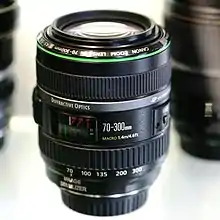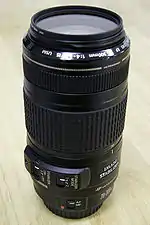The EF 70–300mm lenses are a series of telephoto zoom lenses made by Canon Inc. They have a Canon EF lens mount to work with the EOS line of cameras.
Four Canon EF telephoto zoom lenses carry the 70–300mm designation.
- EF 70–300mm f/4.5–5.6 DO IS USM
- EF 70–300mm f/4–5.6L IS USM
- EF 70–300mm f/4–5.6 IS USM
- EF 70–300mm f/4–5.6 IS II USM
All versions offer image stabilization (IS) and ultrasonic motor drive (USM) and have nearly the same maximum aperture of 4/4.5 to 5.6 over their entire focal range.
EF 70–300mm f/4.5–5.6 DO IS USM

This lens makes use of Canon's Diffractive Optics rather than a traditional lens of wholly refractive design. This allows the lens to be more compact, albeit heavier and much more expensive than a lens of conventional design. The lens contains Image Stabilization and a ring USM, which allows full-time manual focusing of the lens while using the camera in single shot mode. This lens offers good optical quality with the caveat that the diffractive element does not deal with strong incident light sources as well as conventional designs.[1]
EF 70–300mm f/4–5.6 IS USM

This lens is of a conventional design and was introduced in 2005, to offer an increase in performance from the earlier 75-300mm lenses in the Canon EF lens lineup.[3][4] Like the 70–300mm f/4.5–5.6 DO it contains an image stabilizer; however, for focusing it uses the lower quality micro-USM design, and therefore requires the focus motor to be disengaged before manual focusing. The optical performance of this lens is competitive to Canon's L series telephoto zoom lenses, such as the 70–200mm series of lenses. This is because it features an ultra-low dispersion glass element, something that is uncommon for a consumer grade lens, and is usually found only in Canon's L-series lenses. This lens is also notable for having only a slight decrease in performance as the focal length goes beyond 200 mm.[5] That is an uncommon attribute of consumer grade zoom lenses and is not the case for the old 75–300mm lens.
EF 70–300mm f/4–5.6L IS USM

Introduced on 26 August 2010, this lens is in Canon's L-series range of professional lenses. The lens includes 19 elements in 14 groups, two of which are ultra-low dispersion (UD) glass. It is designed to provide professional photographers the 70–300mm zoom range without sacrificing high image quality. The 70–300mm f/4–5.6L IS USM is the only L-series 70–300mm lens and is the only to feature weather sealing. The image stabilizer is rated for 4 stops and allows sharp pictures to be taken handheld at speeds as slow as 1/8 of a second. This lens has superb contrast that meets or exceeds other L-series telephoto zooms, but lacks in sharpness in the corners throughout most of its focal length range. The image quality at 300mm does not degrade, making it distinct from the other 70–300mm lenses. Barrel distortion is average for this class of lens, but vignetting is better than average. Because of its fast autofocus, useful range, excellent image stabilization, and high image quality, the 70–300mm f/4–5.6L has recently become popular among serious amateur and professional photographers. The 70–300mm f/4–5.6L includes a hood but not a tripod ring.
EF 70–300mm f/4–5.6 IS II USM
Introduced on 15 September 2016, Canon EF 70-300mm f/4-5.6 IS II USM lens is the second Canon lens equipped with Nano USM technology, a focusing motor that combines the benefits of a ring USM (ultrasonic motor) for high-speed AF during still photo shooting and lead-screw type STM (stepping motor) for smooth and quiet video autofocusing (AF).[6] The lens also features a new LCD information display and four-stop image stabilization. It was available in November 2016, for an estimated retail price of $549.99.[6] To support this new lens, some Canon cameras needed a new firmware.[7]
Specifications
| Attribute | f/4.5–5.6 DO IS USM | f/4–5.6 IS USM | f/4–5.6L IS USM | f/4–5.6 IS II USM |
|---|---|---|---|---|
| Image stabilizer | Yes, 3rd generation | Yes, 4th generation | ||
| Environmental Sealing | No | Yes | No | |
| Ring USM | Yes | No | Yes | No |
| Micro USM | No | Yes | No | |
| Nano USM | No | Yes | ||
| L-series | No | Yes | No | |
| Diffractive Optics | Yes | No | ||
| Ultra-low dispersion glass element | No | Yes | ||
| Macro | No | |||
| Maximum aperture | f/4.5–5.6 | f/4–5.6 | ||
| Minimum aperture | f/32–38, f/32–40 (1/3-stop increments) |
f/32–45 | ||
| Weight | 720 g | 630 g | 1050 g | 710 g |
| Max. Diameter x Length | 82.4 × 99.9 mm | 76.5 × 142.8 mm | 89 × 143 mm | 80 × 146 mm |
| Filter diameter | 58 mm | 67 mm | ||
| Horizontal viewing angle | 29°–6°50' | |||
| Vertical viewing angle | 19°30'–4°35' | |||
| Diagonal viewing angle; | 34°–8°15' | |||
| Groups/elements | 12/18 | 10/15 | 14/19 | 12/17 |
| # of diaphragm blades | 6 | 8 | 9 | |
| Closest focusing distance | 1.4 m | 1.5 m | 1.2 m | |
| Maximum Magnification | 0.19× | 0.25× | 0.21× | 0.25× |
| Release date | January 2004 | August 2005 | October 2010 | September 2016 |
| MSRP US$ | $1,149.88 | $549.00 | $1,349.00 | $549.00 |
References
- ↑ "Canon EF 70–300mm f/4.5–5.6 USM DO IS — Full Format Review / Test Report" at photozone.de (Retrieved 5 October 2010)
- 1 2 "Canon website's lens compatibility list for the ET-65B lens hood". Archived from the original on 21 March 2016. Retrieved 5 October 2010.
- ↑ "Canon EF 70–300mm f/4–5.6 USM IS — Review / Test Report" at .photozone.de (Retrieved 5 October 2010)
- ↑ Canon EF 70–300mm f/4–5.6 IS USM Lens Review at the-digital-picture.com (Retrieved 5 October 2010)
- ↑ "Canon EF 70-300mm f/4-5.6 IS USM Lens Review".
- 1 2 "Lenses | Canon U.S.A., Inc".
- ↑ "Canon Releases Firmware Updates for Multiple Cameras". 29 September 2016.